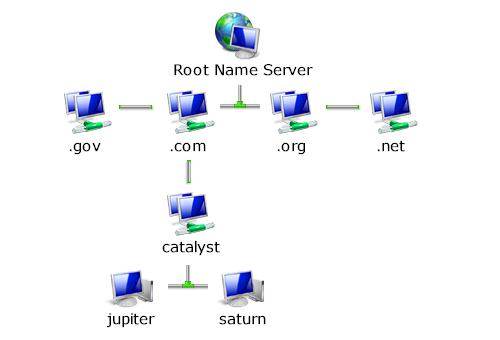An application must have several pieces of information to exchange data with a program running on another system. The first is the Internet Protocol (IP) address of the computer system on which the other program is running. Although this address is internally represented by a numeric value (either 32 or 127 bits wide), it is typically identified by a logical name called a host name or fully qualified domain name. Host names are divided into several parts separated by periods, called domains. The structure is hierarchical, with the top-level domains defining the type of organization that network belongs to, and sub-domains further identifying the specific network. Everyone who has used a web browser is familiar with host names such as www.microsoft.com.

In this figure, the top-level domains are "gov" (government agencies), "com" (commercial organizations), "edu" (educational institutions) and "net" (Internet service providers). The fully qualified domain name is specified by naming the host and each parent sub-domain above it, separating them with periods. For example, the fully qualified domain name for the "jupiter" host would be "jupiter.sockettools.com". In other words, the system "jupiter" is part of the "catalyst" domain (a company's local network) which in turn is part of the "com" domain (a domain used by all commercial enterprises).
To use a host name instead of an IP address to identify a specific system or network, there must be some correlation between the two. This is accomplished by one of two means: a local host table or a name server. A host table is a text file that lists the IP address of a host, followed by the names by which it is known. A name server is a system which can be presented with a host name and will return that host's IP address. This approach is advantageous because the host information for the entire network is maintained in one centralized location, rather than being scattered over every system on the network.
The standard protocol used to convert a host name into an IP address is called the Domain Name Service (DNS) protocol. All of the SocketTools networking libraries have the ability to automatically convert between host names and IP addresses, and in most cases they can be used interchangeably. For example, those methods which require that you specify the name of a server to connect to, you can use either its host name or its IP address. In addition, SocketTools has a control that specifically supports the Domain Name Service protocol, enabling your application to send specialized queries to the name server. Later in the Developer's Guide there will be information about how DNS can be used in a number of different types of applications.
Copyright © 2025 Catalyst Development Corporation. All rights reserved.